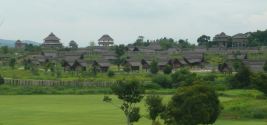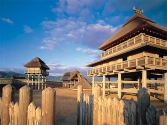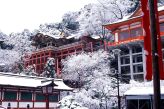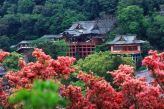History of Saga 佐賀の歴史
In ancient times, Saga prefecture and Nagasaki prefecture were combined and given the name Hizen Province. Rice farming culture was introduced to Saga while ruins of Nabatake could be seen in Karatsu and the Yoshinogori site. During the Edo period, this area was called the Saga domain, and it also included three other sub-domain. In the mid 19th century, industries such as green tea, and coal were encouraged. After the Boshin War, a civil war in Japan, many citizens in Saga supported the Meji Restoration, while during the Meji era, modernization of coal and railroads occured.
Yoshinogori historical park 吉野ヶ里
The Yoshinogori site ruins has extremely academic value and are well preserved until this day. Dated back to the Yayoi Period which is from 300BC to 300 AD, this historical park provides a unique chance for visitors to under more about the Yayoi Period. The Yayoi period mared the start of rice caltivation, and the settlement of the Japanese.
Access Information:From JR Nagasaki Honsen Line local train to JR Kanzaki Station approximately 9 min
JR Yoshinogari Park Station approximately 12 min
or bus transportation
Nishitetsu Bus [Yoshinogari ISEKI MAE] stops in front of the Park
Nishitetsu Bus [Tade] It takes approximately 7 min. from this stop
Tel: 0952-55-9333
Address:1843 Tade, Yoshinogari-cho, Kanzaki-gun, Saga
Opening hours and Fees: 9:00am-17:00pm (June to August is until 18:00)
Admission Fee: Adults(Age 15 and above) 400 Yen Children(Elementary to High school) 80 yen
Children(Age 6 and or under) Free Parking Fee: 300 yen
Link to homepage: http://www.yoshinogari.jp/en/
More information:http://www.jnto.go.jp/eng/location/spot/thempark/yoshinogarihistorical.html
Yutoku Inari Shrine 祐徳稲荷神社
Yutoku Inari Shrine is one of the three greatest Inari Shrines in Japan. Inari is the god of harvest , many come to pray for their famil, business , traffic safety and others. The Shrine is very popular among the locals and aorund 2.8 million visits the Shrine every year. Also, visitors can draw a fortune slip that will tell them if they will recieve good luck or bad luck soon.
Access Information:JR Trains: Take the JR Nagasaki Main Line to Hizen Kagoshima Station. At the Kashima Bus Center located in the front of the train station, take the Yutoku Bus bound for Yutoku-jinja until Yutoku-jinja-mae Bus Stop. It is a 5 minute walk from this stop.
Address:Furueda, Kashima-shi, Saga
Tel: 0954-62-2151
Link to homepage: http://www.yutokusan.jp/
Moreinformation:http://www.welcomekyushu.com/event/?mode=detail&isSpot=1&id=9999900000145
Saga city Cultural Museum
Due to the fact that Saga is facing towards the Korean Pennisula with the Sea of Japan in the middle, Saga has been significantly effected by Korea and China. Along with potterys, Saga is also known to be home of ceremics.
Old Banks, Koga residence and the old mercant residence-Old Ushijima Residence are preserved within the museum. The Old Koga bank allows visitors to experience what a bank was like during the Meji era while the old residences depicts the modern Japanese architect during the Taisho period.
Address:2-9 Yanagi-machi, Saga City
Tel: 0952-22-6849
Opening Hours:9:00-17:00
Closed: Mondays
Admission fee: Free
Link to homepage: http://sagarekimin.jimdo.com/english/
Karatsu Castle 唐津城
Karatsu Castle , also known as the "Dancing Crane Castle"( 舞鶴城,)is located in Karatsu , Saga and a castle located on a hilltop. Constuction of the castle started in 1602 and was finished in 1609, it is built by Teresawa Hirotaka who is the lord of Karatsu in 1595. Ancient soldier ware, spears, swords and other artifacts are exhibited within the castle.
Access information: From Karatsu station by bus around 20 minutes
Tel: 0955-72-5697
Address:〒847-0016 Maizuru Koen, Higashijonai, Karatsu-shi, Saga-ken
Opening hour: 9:00 to 16:40
Admission Fee: To the castle keep 400 yen
Saga Castle 佐賀城
Saga Castle is a hiraijiro, a castle built on plain land instead of on a mountian or hill. It was finished in 1611 by Nabeshima Clan. It was burnt down in 1726 and was reconstructed in the last years of the Edo Period. Displayed inside the castle are Japanese architecture such as paper screens , sliding shutters and tatami etc. The highlights includes a 45 meter long tatami corridor.
Access Information: Saga Sta. (Nagasaki Line); 10 min bus. From JR Saga station - 25 minute walk
About 10 by taxi (approximately 1000 yen)
Tel: 0952-40-7112
Opening hours for the museum nearby: 9:30 - 18:00 Parking fees: Free
Link to homepage(museum):http://sagajou.jp/english/overview.html
Kyushu Ceremics Museum
" The Kyushu Ceramics Museum showcases the art work of modern day artisans. The exhibition rooms are separated into five where visitors can acquire a deeper understanding of the character, art work and history of the ceramics of Kyushu. In the General Exhibition Room is a music box clock made out of “Akita Yaki” porcelain which chimes every 30 minutes. On an outer wall of the building are 25 ceramic bells given to the museum by the German city of Meissen, the sister city of the town of Arita. These bells make the surrounding area reverberate with their beautiful and clear notes every hour."
For more information: http://www.pref.saga.lg.jp/web/var/rev0/0117/0398/201272510245.pdf
Link to homepage:
http://www.pref.saga.lg.jp/web/at-contents/kanko_bunka/k_shisetsu/kyuto.html










